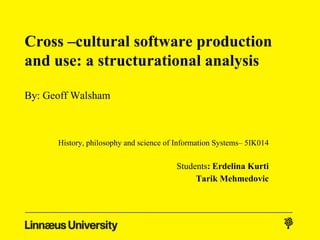
Cross cultural software production and use
- 1. Cross –cultural software production and use: a structurational analysis By: Geoff Walsham History, philosophy and science of Information Systems– 5IK014 Students: Erdelina Kurti Tarik Mehmedovic
- 2. What is the key question that the author addresses in the text? • To examine cross-cultural software production and use, by developing a theoretical basis for analysis. • This is done by using concepts drawn from structuration theory. • One of the key questions is to compare effectiveness of this analysis to Hofstede-type studies.
- 3. How do they motivate the importance of the question(s)? • Hofstede-type studies dominant in IS research in examining culture, are considered to be lacking when describing key concepts in cross-cultural interaction such as conflict, heterogeneity and the dynamic nature of culture. • ICTs are inherently problematic in cross-cultural environments, due to different perceptions of the relevance, applicability and value of working modes and use of ICTs.
- 4. Structuration theory • Treats human actions and social structure as a duality rather than a dualism • Social phenomena is not a product of either structure or human actions, but of both. • Social structure is not independent of agency, nor is agency independent of structures. • Human agents draw on social structures in their actions, and at the same time these actions serve to produce and reproduce social structure.
- 5. Structuration theory concepts • Agency is the ‘capacity to make a difference” (transformative capacity) • System consists of relations between actors or collectiveness reproduced across time and space. • Structure is regarded as rules (routines, norms) and resources that are recursively implicated in social reproduction and exist only as memory traces, the basis of human knowledgeability and as instantiated in action. • Structuration refers to conditions governing the continuity or transformation of structures, and therefore the reproduction of social systems. The emphasis is on the interplay between individuals and society.
- 6. Structuration theory concepts • Agent - human being with transformative capacity, power to intervene or to refrain from intervention. • Power involves the exploitation of resources. Power is not a resource, but resources are media through which power is exercised • Resources are structured properties of social systems, drawn on and reproduced by knowledgeable agents in the course of interaction. – authoritative, transformative capacity generating commands over persons or actors – allocative, transformative capacity generating commands over objects, goods, material phenomena
- 7. The duality of structure The dimensions of the duality of structures adopted from Giddens (1984), (Jones, M.R., 2008)
- 8. How do they produce their argument(s) to the question(s) addressed? • The author develops key concepts to help find a new way of examining cross-cultural factors in ICT.
- 10. Case study 1: • Jamaican general insurance company • Capital base of general insurers is insufficient, thus they rely on world wide reinsurers. • There was a decision to develop a new general insurance information system. • Indian software developers were recruited. • Conflict arise between Indians and Jamaicans at senior level • Different management styles • Project that was supposed to be finished within 1 year, it remained a promise rather a reality after 5 years.
- 11. Case study 1: Structurational analysis
- 12. Case study : Technology Transfer of GIS Software • Development and usage of GIS systems in district administration in India (1991-1996). • The National Wastelands Identification Project required mapping of wasteland distribution with the purpose of development of wasteland areas. • Project conducted in cooperation of US and Indian scientists, passed on to district administrator for further utilization. • Two phases; project eventually failed due to non- usage.
- 13. Case study : Technology Transfer of GIS Software
- 14. Different Theories in Cross-Cultural Working and IS • According to Myers and Tan ( ), most of the literature on cultural and cross-cultural aspects in IS has so far relied on the work of Hofstede ( , ); out of studies. • His work shows cultural differences as scored across five dimensions: power- distance, individualism, masculinity, uncertainty avoidance, long-term orientation. • The author criticizes this approach due to its insufficient ability to deal with dynamic aspects of culture.
- 15. Different Theories in Cross-Cultural Working and IS • Advantages of structurational analysis are shown against disadvantages of Hofstede-type analysis. • These are grouped under four headings relevant to the dynamic factors of cross-cultural interaction displayed in the cases. • Hofstede theory is criticized on grounds of disregard for heterogenity, specific work patterns, conflict and the dynamic aspects of culture.
- 17. What is the key message of the paper that the author(s) try to send to the readers? • Structuration analysis offers deeper insights than Hofstede-type studies. • Dynamic aspects of culture is a crucial factor in success of software production and use endeavors in multi- cultural environments. • Attempt to provide a theoretical basis for future analysis of cross-cultural software production and use
- 18. What are the potential positive benefits, that the authors state themselves, of the key message of the text? • Attempt to provide a theoretical basis from structuration theory for future analysis of cross-cultural software production and use. • Contribution to understanding of issues involved in the cross-cultural aspect of software production and use.
- 19. Strengths • Recognizes the limited ability of Hofstede-type studies in analyzing dynamic aspects of culture. • Well defined limitations of the paper.
- 20. Limitations • Empirical data is drawn from only two case studies. • Case studies are presented very briefly and are lacking details • Some of they key concepts in his framework are not represented well in the cases such as reflexivity and change. • Weak reference to the original Gidden’s Duality of structures
- 21. THANK YOU